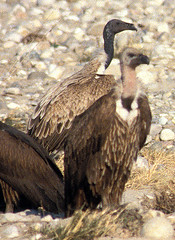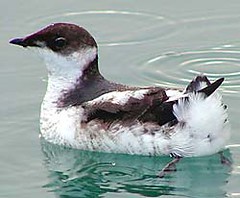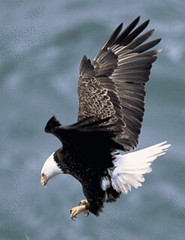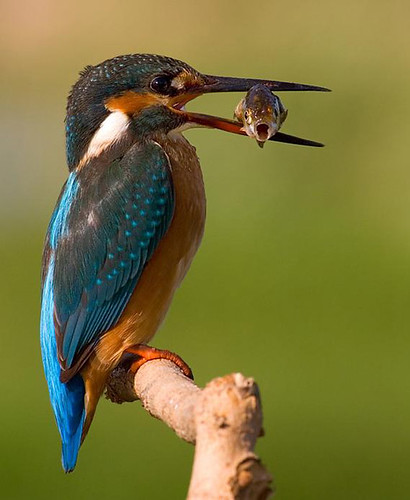Common Kingfisher, Alcedo atthis.
Image: by kind permission of Seve Round.
People Helping Birds
In an innovative measure to save endangered vultures, Nepalese conservationists have set up clean feeding centres where the large fliers can have their favourite food that is free from killer toxins. The vulture restaurants are attracting the birds from distant places raising the hope that the uncontaminated diet would help recover the South Asian birds under critical decline. Three vulture species of Nepal, India and Pakistan were pushed to the verge of extinction due to the chemical contamination of cattle carcasses which the birds feed on. Scientists have confirmed that widely used veterinary drug Diclofenac was responsible for over 90 per cent mortality of the Slender-billed, White-backed and Long-billed vultures in Indian sub-continent. "Cattle carcasses still continue to be contaminated with Diclofenac resulting in vulture deaths, as drug stores are selling the banned substance and some pharmaceuticals did not stop manufacturing it even after the government ban" said Hem Sagar Baral, Nepal's top bird scientist, who is affiliated with the Bird Conservation Nepal (BCN).
Endangered Birds
 Researchers in the remote forests of Cambodia said they have discovered the only known colony in Southeast Asia of slender-billed vultures, Gyps tenuirostris (pictured), and scores of other endangered birds. The colony was discovered last month in the jungles east of the Mekong River in Cambodia's Stung Treng Province. "We discovered the nests on top of a hill where two other vulture species were also found," said Song Chansocheat, manager of the Cambodia Vulture Conservation Project. "Amazingly, there were also a host of other globally threatened species of birds and primates. It's a very special place."
Researchers in the remote forests of Cambodia said they have discovered the only known colony in Southeast Asia of slender-billed vultures, Gyps tenuirostris (pictured), and scores of other endangered birds. The colony was discovered last month in the jungles east of the Mekong River in Cambodia's Stung Treng Province. "We discovered the nests on top of a hill where two other vulture species were also found," said Song Chansocheat, manager of the Cambodia Vulture Conservation Project. "Amazingly, there were also a host of other globally threatened species of birds and primates. It's a very special place."
 The joint federal/state effort to re-establish an eastern flock of migrating whooping cranes, Grus americana (pictured, Image: Marcus Martin), known as the Whooping Crane Eastern Partnership, is intended to restore a second self-sustaining migratory population of cranes in case some sort of natural calamity should kill the birds in the western flock that nest in Wood Buffalo National Park in Canada and winter at Aransas National Wildlife Refuge in Texas. The possibility that some disaster like that could happen almost came eerily true last Friday when severe storms battered Florida, not only killing several people but also 17 juvenile whooping cranes that migrated there from Wisconsin. "This just demonstrates and reinforces the need for a second population, showing how fragile these populations can be where one disastrous weather event could indeed wipe out a flock," said John Christian, assistant regional director of the U.S. Fish and Wildlife Service in the Twin Cities.
The joint federal/state effort to re-establish an eastern flock of migrating whooping cranes, Grus americana (pictured, Image: Marcus Martin), known as the Whooping Crane Eastern Partnership, is intended to restore a second self-sustaining migratory population of cranes in case some sort of natural calamity should kill the birds in the western flock that nest in Wood Buffalo National Park in Canada and winter at Aransas National Wildlife Refuge in Texas. The possibility that some disaster like that could happen almost came eerily true last Friday when severe storms battered Florida, not only killing several people but also 17 juvenile whooping cranes that migrated there from Wisconsin. "This just demonstrates and reinforces the need for a second population, showing how fragile these populations can be where one disastrous weather event could indeed wipe out a flock," said John Christian, assistant regional director of the U.S. Fish and Wildlife Service in the Twin Cities.
 The marbled murrelet, Brachyramphus marmoratus (pictured, Image: Rich MacIntosh, USGS), a threatened sea bird whose rare trait of nesting in old-growth forests made it a factor in logging battles in the U.S. Northwest, is also declining dramatically in Alaska and Canada, where most of the birds live, according to a U.S. government review. The first comprehensive look at population surveys in Alaska and British Columbia found an overall decline of about 70 percent over the last 25 years, dropping the estimated population to 270,000 birds in Alaska and between 54,000 and 92,000 birds in British Columbia. The bird is not protected in Alaska.
The marbled murrelet, Brachyramphus marmoratus (pictured, Image: Rich MacIntosh, USGS), a threatened sea bird whose rare trait of nesting in old-growth forests made it a factor in logging battles in the U.S. Northwest, is also declining dramatically in Alaska and Canada, where most of the birds live, according to a U.S. government review. The first comprehensive look at population surveys in Alaska and British Columbia found an overall decline of about 70 percent over the last 25 years, dropping the estimated population to 270,000 birds in Alaska and between 54,000 and 92,000 birds in British Columbia. The bird is not protected in Alaska.
 With a court-ordered deadline looming for removal of the bald eagle, Haliaeetus leucocephalus (pictured, Image: USGS), from the endangered species list, the Interior Department, rejecting the advice of its staff wildlife biologists, tried to limit a separate set of protections for the majestic bird that has served as a national symbol for centuries. Public reaction, however, to its December proposal was so sharp that the department had sought a reprieve from the deadline, which it received Wednesday. It now has until June 29 to make its final decision on the eagle's status and the extent of its continuing protections. Rebounding from a historically low population in the early 1960s, the eagle has become a symbol of the success of the 1973 Endangered Species Act. In 1963, there were barely more than 400 breeding pairs in the lower 48 states. Today, the Fish and Wildlife Service at the Interior Department estimates there are more than 7,000 breeding pairs.
With a court-ordered deadline looming for removal of the bald eagle, Haliaeetus leucocephalus (pictured, Image: USGS), from the endangered species list, the Interior Department, rejecting the advice of its staff wildlife biologists, tried to limit a separate set of protections for the majestic bird that has served as a national symbol for centuries. Public reaction, however, to its December proposal was so sharp that the department had sought a reprieve from the deadline, which it received Wednesday. It now has until June 29 to make its final decision on the eagle's status and the extent of its continuing protections. Rebounding from a historically low population in the early 1960s, the eagle has become a symbol of the success of the 1973 Endangered Species Act. In 1963, there were barely more than 400 breeding pairs in the lower 48 states. Today, the Fish and Wildlife Service at the Interior Department estimates there are more than 7,000 breeding pairs.
American Bird Conservancy (ABC) and its partners seeking to acquire habitat for endangered and declining bird species received a major boost with the announcement of a $900,000 challenge grant and $100,000 for other conservation work from New York philanthropist Robert Wilson. "We are thrilled by the huge opportunity Robert Wilson's foresight and dedication presents for conserving the world's rarest bird species," said George Fenwick, President of American Bird Conservancy. "With the average cost to acquire land in South America only $100 per acre, this generous challenge grant means many more imperiled bird species will have a permanent place to call home."
Avian Influenza
Two more Minnesota children have died of influenza, bringing the total to three this flu season, health officials said Thursday. Flu deaths in children are infrequent but not rare. Health officials have said about 100 die each year of complications from the flu. Thirteen children have died of the flu nationally this year, the health department said. "Three of the 13 in Minnesota, that seems unusual but we think it's just the bad luck of the draw, a statistical fluke," said Richard Danila, the deputy state epidemiologist. "There's nothing unusual about the children, they didn't know each other, there's no links, nothing unusual about the virus."
Hundreds of students on the University of Michigan campus are part of a research study that could change the way the world looks at influenza. Researchers are trying to determine whether wearing surgical masks and hand sanitizing can prevent the spread of flu or other respiratory illnesses. Flu hit the university late last month and students in the study have since been divided into three groups: those who only wear masks; those who wear masks and use hand sanitizer; and those who do neither. "We know the clock is ticking, we just don't know when the alarm will go off," said Dr. William Schaffner, chairman of the Department of Preventive Medicine at Vanderbilt University. "We already know there's going to be regular influenza annually, and even that's enough to grab our attention."
Canada's second annual Wild Bird Survey for Avian Influenza (AI) has concluded with more than 12,000 birds tested and no findings of highly pathogenic strains of AI, including the Asian strain of H5N1. Samples for this year's survey were collected from migratory and resident, live and dead, birds across Canada. Additional sampling was conducted in Iceland which is a mingling point for birds from North America and Europe.
Turkey announced today an H5N1 avian influenza outbreak at a farm in the southeastern part of the country, as English authorities explored the possibility of a connection between recent outbreaks in Suffolk and Hungary. Meanwhile, the United Kingdom's Department for Environment, Food and Rural Affairs (DEFRA) said in a press release yesterday that preliminary tests indicate that H5N1 viruses from a turkey farm outbreak may be identical to the virus that caused a recent outbreak in Hungary. Bernard Matthews Holdings, Ltd., the poultry producer that owns the affected farm in England, has an operation in Hungary. Ornithologists are irritated that the government suggested that wild birds were to blame for the outbreak. GrrlScientist note: Once again, all these stories show that the primary spread of avian influenza is through movements of infected domestic poultry. To claim otherwise is irresponsible and just plain disingenuous.
Bird flu has reappeared, after an eight-month lull, on poultry farms in a fourth state in northern Nigeria, officials said. "In the past one week we culled 5,000 chickens following laboratory confirmation of the existence of the avian flu virus in samples of dead chickens," said Bala Usman Suleiman, Bauchi state agriculture commissioner.
Streaming Birds
 This week on BirdNote, for the week of 12 February 2007: Monday, "Old Abe, the War Eagle," a mascot of a Wisconsin infantry regiment in the Civil War; Tuesday, "Roadside Birds"; Wednesday, "Swans on Valentine's Day"; Thursday, "Swan Song," the myth that a swan sings only at the moment of its death; Friday, the Cornell Great Backyard Bird Count, weekend of February 16-19, with a link to sign up. BirdNotes transport the listener out of the daily grind with two-minute vignettes that incorporate the rich sounds of birds provided by Cornell University and by other sound recordists, with photographs and written stories that illustrate the interesting -- and in some cases, truly amazing -- abilities of birds. Some of the shows are Pacific Northwest-oriented, but many are of general interest. BirdNote can be heard live, Monday through Friday, 8:58-9:00AM in Western Washington state and Southern British Columbia, Canada, on KPLU radio and now also in North Central Washington state on KOHO radio. All episodes are available in the BirdNote archives, both in written transcript and mp3 formats, along with photographs. Listener ideas and comments are welcomed. [rss].
This week on BirdNote, for the week of 12 February 2007: Monday, "Old Abe, the War Eagle," a mascot of a Wisconsin infantry regiment in the Civil War; Tuesday, "Roadside Birds"; Wednesday, "Swans on Valentine's Day"; Thursday, "Swan Song," the myth that a swan sings only at the moment of its death; Friday, the Cornell Great Backyard Bird Count, weekend of February 16-19, with a link to sign up. BirdNotes transport the listener out of the daily grind with two-minute vignettes that incorporate the rich sounds of birds provided by Cornell University and by other sound recordists, with photographs and written stories that illustrate the interesting -- and in some cases, truly amazing -- abilities of birds. Some of the shows are Pacific Northwest-oriented, but many are of general interest. BirdNote can be heard live, Monday through Friday, 8:58-9:00AM in Western Washington state and Southern British Columbia, Canada, on KPLU radio and now also in North Central Washington state on KOHO radio. All episodes are available in the BirdNote archives, both in written transcript and mp3 formats, along with photographs. Listener ideas and comments are welcomed. [rss].
Miscellaneous Birds
For the would-be artists out there, five steps to better bird drawing.
The Florida Fish and Wildlife Conservation Commission is looking into the deaths of several loons and pelicans that have turned up on St. Johns County's beaches in recent weeks. The commission's avian mortality veterinarian, Danielle Stanek, said there hasn't been a "drastic" number of deaths reported, but she's looking into it in case there's more to it than survival of the fittest. Stanek, who's based in Tampa, said it's typical for juvenile birds to die off this time of year simply because they can't compete for food with older birds. She suspects that was the case with many of the young birds that were found. But some adult birds are turning up on the beaches, too, Stanek said, so the commission is running tests to find out why.
.
The Fine Print: Thanks to Kellie, Diane, Jeremy, Ellen and Ron for sending story links. Thanks in advance to Ian for catching my typos; as you probably know by now, I put a few typographical errors in these documents just so Ian can find them! The featured image appears here with the kind permission of the photographer, so please contact him if you also wish to purchase this or other of his images. Other images are resized and are either linked from the news story that they accompany or they are credited and linked back to the photographer.
What is the point of Birds in the News? I publish BITN each week because I want to increase people's awareness of the importance of birds in our everyday lives. Birds represent many things to us; beauty, freedom, music, wildness. But everywhere, birds are coming under increasing pressure for their very survival, and by linking to news stories about birds, I hope to make the smallest impression upon the public and the mainstream media, as well as our decision-makers, that birds are an important feature of our everyday lives, that there are so many reasons that we could not do without them.
tags: Birds in the News, ornithology, birds, avian, newsletter



The kingfisher image is really startling. great work with this issue!
I'm impressed for being able to see the eyes of the fish so well! Everything is in focus!
The kingfisher photo is unbelievable. Amazing.
Wonderful collage of birdie info.! I'm always soooo surprised and have realized BITN is addictive. I need my "fix" every monday - Thanks grrlscientist!, you've enabled me to endure another week...:o)
Under the title "people helping birds":
We are happy to announce that the historical Spix's Macaw habitat of Gangorra Farm, totally 400 hectares (1000 acres), has been purchased by the partnership of Parrots International, ACTP and Lymington Foundation for the benefit of the Spix's Macaw Working Group. This partnership was created at the recent meeting of the Spix's MacawWorking Group for the purpose of acquiring Gangorra to protect and restore one of the best historical habitats of the last Spix's Macaw. As you know, the last Spix's Macaw in the wild dissappeared in October 2000 from the Curaca region in the state of Bahia, Brazil. The Spix's Macaw working group is committed to begin reintroduction of the Macaw after habitat restoration of the newly purchased habitat. We hope this is only the beginning of a new chapter in the story of the successful reintroduction of the Spix's Macaw into its historical habitat.
FYI
The Kingfisher at the top of this page is not a Malachite but a Common Alcedo Atthis.